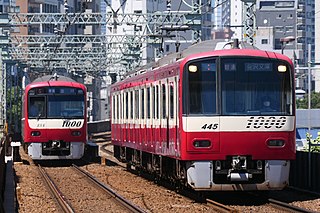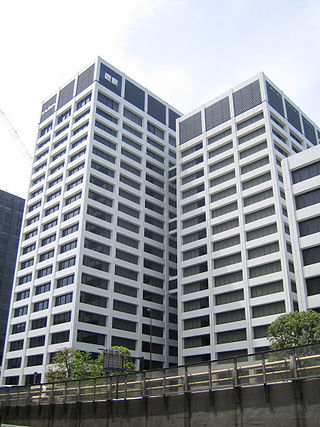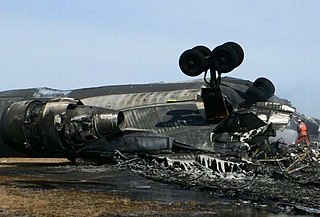Related Research Articles

The Nikkei, also known as The Nihon Keizai Shimbun, is the flagship publication of Nikkei, Inc. and the world's largest financial newspaper, with a daily circulation exceeding 1.73 million copies. The Nikkei 225, a stock market index for the Tokyo Stock Exchange, has been calculated by the newspaper since 1950.

The Yomiuri Shimbun (讀賣新聞/読売新聞) is a Japanese newspaper published in Tokyo, Osaka, Fukuoka, and other major Japanese cities. It is one of the five major newspapers in Japan; the other four are The Asahi Shimbun, the Chunichi Shimbun, the Mainichi Shimbun, and the Nihon Keizai Shimbun. It is headquartered in Otemachi, Chiyoda, Tokyo.

Minato is a special ward of Tokyo, Japan. It is also called Minato City in English.
The Sankei Shimbun, name short for Sangyō Keizai Shinbun, is a daily national newspaper in Japan published by the Sankei Shimbun Co., Ltd, ranking amongst the top 5 most circulated newspapers in Japan.

The mass media in Japan include numerous television and radio networks as well as newspapers and magazines in Japan. For the most part, television networks were established based on capital investments by existing radio networks. Variety shows, serial dramas, and news constitute a large percentage of Japanese evening shows.

Keikyu Corporation, also known as Keihin Kyūkō (京浜急行) or, more recently, Keikyū (京急), is a private railroad that connects inner Tokyo to Kawasaki, Yokohama, Yokosuka and other points on the Miura Peninsula in Kanagawa Prefecture. It also provides rail access to Haneda Airport in Tokyo. Keihin (京浜) means the Tokyo (東京) - Yokohama (横浜) area. The company's railroad origins date back to 1898, but the current company dates to 1948. The railway pioneered Kantō region's first electric train and the nation's third, after Hanshin Electric Railway and Nagoya Electric Railway (Meitetsu) with the opening of a short 2 km (1.2 mi) long section of what later became the Daishi Line in January 1899.

Roppongi Hills Mori Tower is a 54-story mixed-use skyscraper in Roppongi, Minato, Tokyo, Japan. Completed in 2003 and named after builder Minoru Mori, it is the centerpiece of the Roppongi Hills urban development. It is the sixth-tallest building in Tokyo at 238 meters (781 ft). The tower has a floor space area of 379,408 square meters, making it one of the largest buildings in the world by this measure.

Hakuhodo DY Holdings Inc. (株式会社博報堂DYホールディングス) is a Japanese advertising holding company that owns Hakuhodo, Daiko, and Yomiko Advertising. It is the second largest advertising company in Japan, following Dentsu. Its headquarters are located in Akasaka, Minato, Tokyo.

Schindler Holding Ltd. is a Swiss multinational company which manufactures escalators, moving walkways, and elevators worldwide, founded in Switzerland in 1874. Schindler produces, installs, maintains and modernizes lifts and escalators in many types of buildings including residential, commercial and high-rise buildings.

The Keikyu Main Line is a railway line in Japan, operated by the private railway operator Keikyu. The line connects the Tokyo wards of Minato, Shinagawa, Ōta, and the Kanagawa municipalities of Kawasaki, Yokohama and Yokosuka. The Keikyu Main Line began as a short 2 km (1.2 mi) line in 1895. By 1905 it was extended from Shinagawa Station in Tokyo to central Yokohama, becoming a major interurban line between the two cities.

MinebeaMitsumi, Inc. is a Japanese multinational manufacturer of mechanical components and electronic devices. The company's headquarters are located in Higashi-Shinbashi, Minato, Tokyo, and its registered office is located in Miyota, Nagano.

The Takahama Nuclear Power Plant is a nuclear power plant located in the town of Takahama, Ōi District, Fukui Prefecture. It is owned and operated by the Kansai Electric Power Company. It is on a site with an area of about 1 km2. The four pressurized water reactors give the plant a total gross electric capacity of 3,392 MW and average yearly production of 22,638 GWh.

Kajima Corporation is one of the oldest and largest construction companies in Japan. Founded in 1840, the company has its headquarters in Motoakasaka, Minato, Tokyo. The company is known for its DIB-200 proposal. The company stock is traded on four leading Japanese stock exchanges and is a constituent of the Nikkei 225 stock index.

FedEx Express Flight 80 was a scheduled cargo flight from Guangzhou Baiyun International Airport in the People's Republic of China, to Narita International Airport in Narita, Chiba Prefecture, Japan. On March 23, 2009, the McDonnell Douglas MD-11F (N526FE) operating the flight crashed at 6:48 am JST, while attempting a landing on Runway 34L in gusty wind conditions. The aircraft became destabilized at flare and touchdown resulting in an unrecovered "bounced" landing with structural failure of the landing gear and airframe, and came to rest off the runway, inverted, and burning fiercely. The captain and first officer, the jet's only occupants, were both killed.

Masami Tsuchiya was a senior member of Aum Shinrikyo, responsible for the deaths of a combined 19 people and for the production of sarin, VX nerve agent, PCP and LSD. He is also notable for not showing remorse at the trials and remaining loyal to cult leader Shoko Asahara. He was member of the Ministry of Health of the cult, with prosecutors calling him "the second most important figure involved in the gas attacks by the Aum Shinrikyo cult, after cult leader Shoko Asahara himself."
Kanae Kijima, known as The Konkatsu Killer, is Japanese fraudster and serial killer, convicted for poisoning three would-be husbands and suspected of four more, spanning from 2007 to 2009.

Yasunori Suzuki was a Japanese serial killer who robbed and killed three women in Fukuoka Prefecture between December 2004 and January 2005, raping two of them. He was sentenced to death for his crimes, and executed in 2019.

Yasutoshi Kamata, known as The Osaka Ripper, was a Japanese serial killer responsible for the murder and dismemberment of four women and one girl in Osaka between 1985 and 1994. The case was designated by the National Police Agency as "Metropolitan Designated Case No. 122".
The upper-class citizen is a Japanese buzzword used mainly on the Internet to refer to privileged people who are apart from commoners. In 2015 and 2019, the term was nominated for the New Words and Buzzwords of the Year Awards, sponsored by the publisher Jiyukokuminsha.
References
- ↑ "Boy, 16, crushed to death in elevator accident: National: DAILY YOMIURI ONLINE (The Daily Yomiuri)". Archived from the original on 2006-06-23. Retrieved Aug 28, 2020.
- ↑ The Yomiuri Shimbun, "459 Schindler lift problems found", 2006.http://www.yomiuri.co.jp/dy/national/20060610TDY01003.htm
- ↑ [ dead link ]
- ↑ Shimbin, Y., "Lift probe frustrated by service bodies / Housing corp., maintenance firms, manufacturer uncooperative, blame each other" Daily Yomiuri Online, 2006. http://www.yomiuri.co.jp/dy/national/20060611TDY02009.htm
- ↑ "Schindler lists six other elevator malfunctions". The Japan Times. 2006-06-15. Archived from the original on 2011-06-06. Retrieved 2011-04-26.
- ↑ 地域ニュース. 中国新聞デジタル (in Japanese). Archived from the original on June 20, 2006. Retrieved Aug 28, 2020.
- ↑ The Yomiuri Shimbun, "Police pin lift death on brakes", 2006 http://www.yomiuri.co.jp/dy/national/20060618TDY02012.htm
- ↑ http://www.tokyo-np.co.jp/flash/2006062201002359.html%5B%5D
- ↑ The Yomiuri Shimbun, "More Schindler door problems come to light", 2006 http://www.yomiuri.co.jp/dy/national/20060705TDY02005.htm
- ↑ "Police Records of Six Persons from Schindler and Others Sent to Prosecutor's Office" (in Japanese). The Yomiuri Shimun (Evening Edition). March 30, 2009.
- ↑ "Senior Executives to be Indicted: Schindler Elevator Accident" (in Japanese). Mainichi Shimbun (Morning Edition). July 16, 2009.
- ↑ "Schindler's Side Asserts Non-guilt: Fatal Elevator Accident" (in Japanese). Mainichi Shimbun (Evening Edition). March 11, 2013.
- ↑ "Schindler Management Found not Guilty in District Court Ruling for Elevator Fatal Accident of a High School Student: Three Persons from Maintenance Company Found Guilty" (in Japanese). Mainichi Shimbun (Evening Edition). September 29, 2015.
- ↑ "Ex-elevator company executive acquitted, three others given suspended sentences over 2006 fatality". The Japan Times. September 29, 2015.
- ↑ "Schindler Employee not Guilty in District Court Ruling for Elevator Fatal Accident" (in Japanese). The Nikkei (Evening Edition). September 29, 2015.
- ↑ "Elevator Accident: Former Schindler Employee Found Innocent Again in Appelalte Trial" (in Japanese). The Nikkei (Morning Edition). January 27, 2018.
- ↑ "Acquittal Final in Schindler Accident Trial: Prosecution Decides to Forego Appeal" (in Japanese). The Nikkei (Evening Edition). February 10, 2018.
- ↑ "Tokyo High Court acquites three over fatal elevator accident". The Japan Times. March 14, 2018.
- ↑ "Schindler Elevator Accident: Three People from Maintenance Company Found Not Guilty, in Reversal of District Court Decision" (in Japanese). The Nikkei (MorningEdition). March 15, 2018.
- ↑ "Schindler Accident: Prosecution to Forego Appeal - Acquittal of Three Persons from Maintenance Company to Become Final" (in Japanese). The Yomiuri Shimun (Morning Edition). March 27, 2018.
- ↑ "Fatal Accident Involving 2nd Year High Schooler, Schindler Sued for Compensation: Bereaved Family Says the Firm 'Recognized Danger but Did Nothing'" (in Japanese). The Nikkei (Evening Edition). December 12, 2008.
- ↑ "Crushed teen's kin settle civil suit with Schindler Elevator". The Japan Times. November 25, 2017.
- ↑ "Schindler and Bereaved Family Reach Reconciliation in Elevator Accident: Company Promises to Prevent Recurrence" (in Japanese). The Nikkei (Evening Edition). November 24, 2017.
- ↑ "Schidler Elevator Accident: Minato Ward Sues for Damages from Four Companies for Replacement Costs, etc" (in Japanese). Tokyo Shimbun (Morning Edition). July 7, 2010.
- ↑ "Bill No. 126"On Settlement"" (in Japanese). Minato Ward City Council. December 6, 2019.
- ↑ "Cabinet Order No. 338, 1950, Article 219-10" (in Japanese). Kenchiku Kjiun ho seko-rei (Enforcement Order of the Building Standards Law). September 28, 2009.
- ↑ "One Step Towards Mandatory Auxiliary Brakes: Enforcement of the Revised Law Regarding Safety Improvements for Elevators" (in Japanese). The Nikkei (Evening Edition). September 28, 2009.
- ↑ "MLIT to Investigate Elevator Safety: First Ever Nationwide Survey of Elevator Safety Devices Installed at Local Government Buildings" (in Japanese). Tokyo Shimbun (Evening Edition). October 9, 2019.
- ↑ "Fatal Elevator Accident in Takeshiba (Minato Ward), Tokyo: Minato Ward to Provide Subsidies to Install Safety Devices" (in Japanese). Mainichi Shimbun (Evening Edition). February 4, 2016.
- ↑ "Asia Times Online :: Japan News and Japanese Business and Economy". Atimes.com. 2006-06-13. Archived from the original on 2007-03-23. Retrieved 2011-04-26.
{{cite web}}: CS1 maint: unfit URL (link) - ↑ エレベーターに不安感じる65%、学生意識調査 (in Japanese). News.livedoor.com. Archived from the original on 2006-07-09. Retrieved 2011-04-26.
- ↑ [ permanent dead link ]
- ↑ シンドラー社、新たな不具合公表 113基ソフト交換. Asahi Shimbun. Archived from the original on 2006-07-21. Retrieved 2006-07-21.